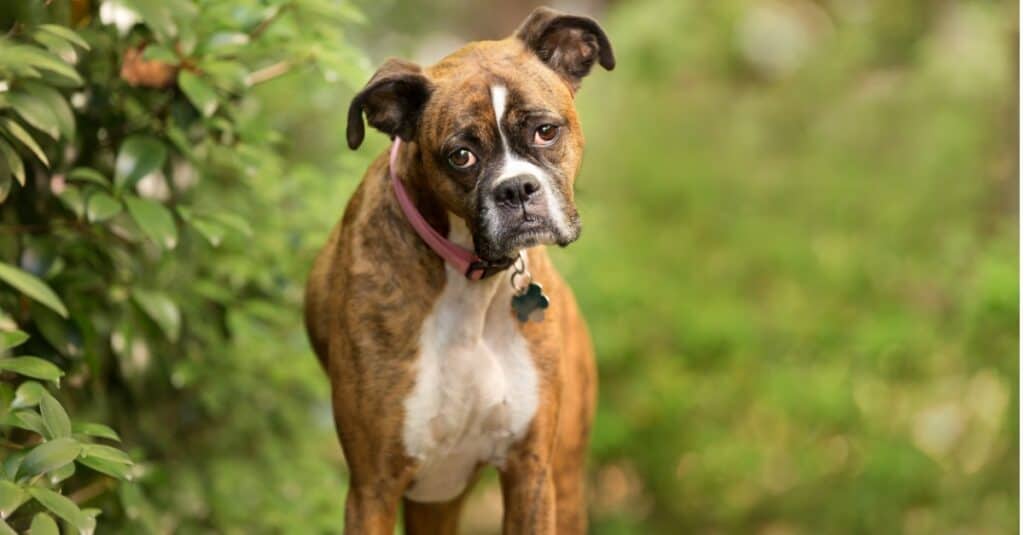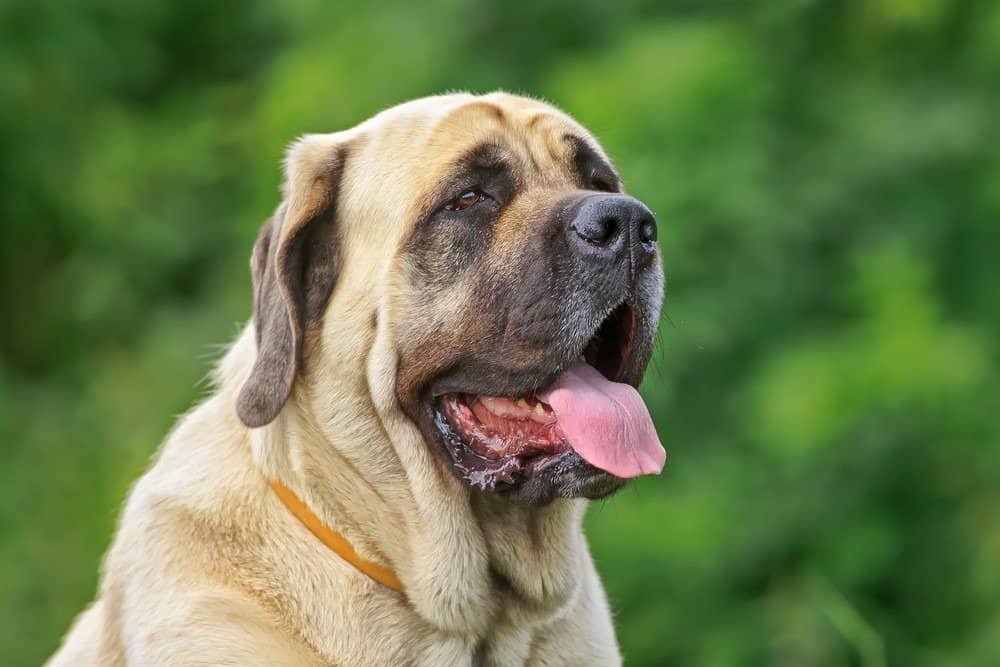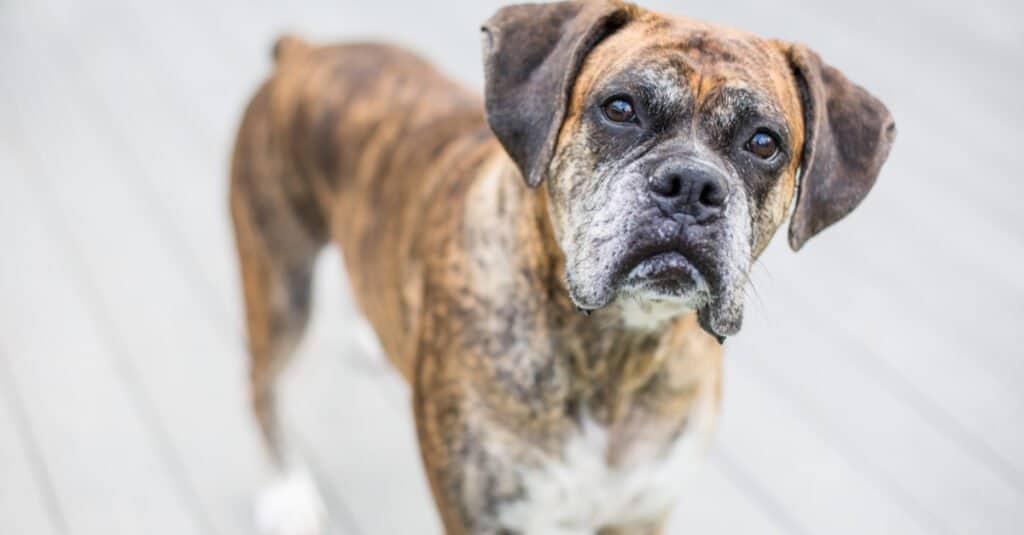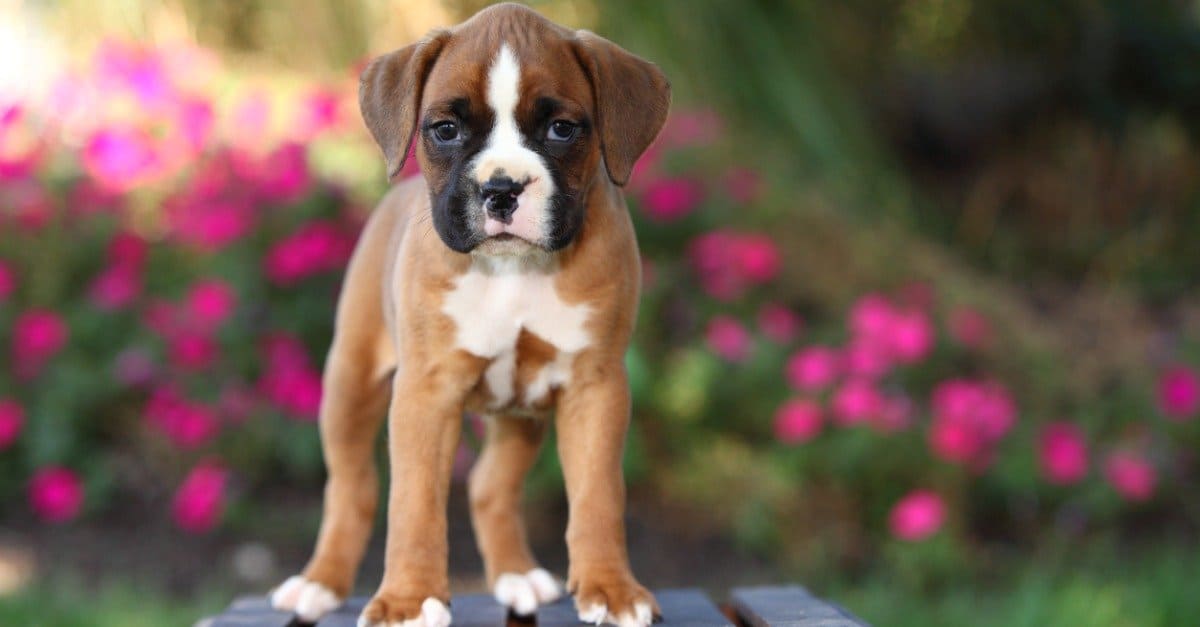Key Facts:
- Boxers were bred by crossing the Bullenbessier with the mastiff, in 19th century Germany.
- It is believed they owe their name to the boxing motion they make when standing on their hind legs.
- They generally live for a maximum of 12 years, although certain lucky pooches get to live for longer.
Boxers are fun-loving and affectionate dogs with an average life expectancy of 10-12 years. Yet, a few older boxers have proven this handsome breed can live even longer.
We’ll take a look at boxer traits, their origins in Germany, and learn the stories of the oldest boxers on record.
Traits Of Boxer Dogs

The average lifespan of a boxer dog is approximately 10 to 12 years.
©iStock.com/AprilCarlsonPhotography
The boxer has a medium, muscular build and stands up to 25 inches high. Its coat is short and smooth, with either fawn or brindle coloring (brown and tan streaks) plus white. Some boxer dogs are all white or have mainly white markings with small patches of other colors. Boxers also have square jaws and slightly wrinkled fur on their foreheads.
The boxer’s short, broad head has a distinctive shape known as brachycephalic. Boxer puppies have a temporary bony bump on the top of their skulls, called an occiput, to protect their developing brain.
The American Kennel Club (AKC) classifies the boxer as a working group breed. Working dogs were initially bred to help humans with various jobs like pulling sleds or guarding property.
Boxers descended from mastiff dogs and were first used primarily for hunting.
Origins Of The Boxer Breed

The mastiff along with the now extinct Bullenbessier are the ancestors of the boxer.
©Michal Ninger/Shutterstock.com
The boxer breed was developed in the 19th century in Germany by mixing mainly mastiffs with the now-extinct German bulldogs called Bullenbessier. However, it’s possible boxers also descend from Great Danes and terriers.
It wasn’t long after boxer dogs arrived on the scene that they were a favorite at exhibitions. The first Boxer Club for show dogs was started in Germany in 1896. The American Kennel Club registered boxers in the United States in 1904.
The first boxer to win an AKC championship was a dog named Dampf vom Dom in 1915.
Why Are They Called Boxers?
Though it can’t be confirmed, many believe that boxer dogs got their name because of their habit of moving their front paws in a boxing motion while standing on their hind legs. It’s also possible the word boxer is derived from the German word Boxl, another name used for the Bullenbessier dog.
Charles Dickens referred to a dog as a boxer in his novella The Cricket on the Hearth, published in 1845. However, because Dickens wrote his book before the modern boxer dog existed, some believe this story may have inspired the breed’s name.
The Oldest Boxer Ever

The oldest boxer lived to be 16 years old
©Tara Lynn and Co/Shutterstock.com
The oldest boxer ever was a male named Maccabee, who lived to be 16 years and nine months old. Maccabee was born on October 28, 1999, and died on July 28, 2016. He was owned by Jessica Kolis and lived in Northern California.
Maccabee was healthy for the first 8-10 years of his life, then began developing health issues. He eventually lost much of his hearing and became blind before dying at nearly 17 years old.
Jessica, Maccabee’s owner, believes the reason her boxer lived so long was that he got regular checkups and dental treatments. Boxers are prone to dental issues, so Maccabee was lucky that his owner often brushed his teeth.
Another key to Maccabee’s longevity was providing him with lots of physical activity and mental stimulation. Boxers are active dogs that need at least 2 hours of exercise a day to stay happy and healthy for many years.

White boxers are thought to have more health problems than those of other colors.
©iStock.com/Amanda Woldt Photography
Old Boxer Dogs: More Boxers That Lived Long Lives
The second oldest boxer ever was a male named Brewski, who lived for 16 years, five months, and 28 days. Brewski was born on February 7, 2001, and died on August 5, 2017. He was owned by Linda Klosterman and lived in Vancouver, Washington.
In his senior years, Brewski developed arthritis in his lower back. Daily exercise and maintaining a healthy weight can help prevent boxers from developing arthritis unless caused by an injury.
The third oldest boxer ever was a female named CeCe, who lived for 16 years, four months, and 22 days. CeCe was born on December 1, 2000, and died on April 23, 2017. She was owned by Sophy Korm in Wake Forest, North Carolina.
In her later years, CeCe also developed arthritis, plus cataracts. In addition to cataracts, boxers can develop other eye problems of the cornea and retina. Therefore, it’s essential to have a boxer’s eyes checked regularly by a veterinarian to prevent minor eye issues from eventually causing blindness.
Unique Boxer Dog Facts

Boxers are loyal and friendly dogs no matter how long they live.
©iStock.com/michael_lofenfeld
Did you know that boxers are born with three eyelids? Their upper eyelid has two layers, creating a third eyelid that isn’t ordinarily visible. However, the third eyelid can migrate and become misplaced over a boxer’s eye, causing a condition called cherry eye. This condition is noticeable due to the appearance of redness or a red film over the dog’s eye.
The boxer has prominent jowls and drools a lot. If you own boxers, you’ll need to follow them around with a cloth to wipe their mouths now and then!
Boxers have unusually long tongues. They might have the longest tongue of all dog breeds. According to Guinness World Records, the dog with the longest tongue ever was a boxer named Brandy whose tongue was 17 inches long!

The boxer’s short, broad head has a distinctive shape known as brachycephalic.
©iStock.com/JLSnader
Can you guess which has more energy, the boxer male or the female? The female boxer is more hyperactive and will need multiple hours per day to play and exercise.
Don’t let your boxer dog on the bed if you’re trying to get some deep restorative sleep! Boxers are known for their loud snoring. Sometimes they even snore while sleeping with their eyes open.
Despite their snoring, boxers can make excellent snuggle buddies. Unfortunately, their short coat finds them feeling chilly in colder weather, so a boxer dog will look for a warm place to nestle for a nap.
Overall, the boxer is a friendly, loyal dog and a fun family pet if it gets enough loving attention and daily exercise.
The photo featured at the top of this post is © Tara Lynn and Co/Shutterstock.com
Ready to discover the top 10 cutest dog breeds in the entire world?
How about the fastest dogs, the largest dogs and those that are -- quite frankly -- just the kindest dogs on the planet? Each day, AZ Animals sends out lists just like this to our thousands of email subscribers. And the best part? It's FREE. Join today by entering your email below.
Thank you for reading! Have some feedback for us? Contact the AZ Animals editorial team.







